Living in a toy hauler, I suppose, is probably not that much different than living in a travel trailer, except for three major things…
- A toy hauler has that ramp door in the back,
- A toy hauler has that ugly floor with D-rings in it, and
- Toy haulers are designed for larger cargo carrying capacities.
We’re often asked what it’s like living full time in a toy hauler, so here goes..
The Ramp Door
Living in a toy hauler means having to look at the big black non-skid surface in the back. Meanwhile in a travel trailer, you get that beautiful wide window in the back, along with all the natural light that comes in.
Ramp doors are also not well insulated because they are criss-crossed with support beams. That means if the sun shines directly on the door, all that heat will pass through into the trailer. That makes it difficult for the air conditioner to keep up. The same is true with cold.
But that ramp door has some advantages…
- Of course, it means being able to lower the door and roll in some large items that you could not carry in through the front door. Stuff like a new couch, a new recliner, or a residential mattress. Let’s not forget bicycles, scooters, motorcycles, quads, razors, side-by-sides, even cars and Jeeps. But then again, rolling in those larger vehicles means having to make room for them by moving your other stuff out of the way. If you have a lot of stuff, that’s not so easy.
- But another advantage is that it can double as an outdoor deck. You can attach cables to the door so that it lays flat, as an outdoor extension to the floor. Then, set up patio chairs, a table, and a barbecue grill, and take RVing to a new level.
- You can also drape bug netting (check this link on Amazon) over the ramp door. Then, drop the door, and you have a very wide window that lets the breeze run through the trailer.
- The ramp door also makes vacuuming the floor very easy. Actually, you don’t vacuum, you sweep. Just lower the ramp door, and sweep everything out. I know some guys who use a leaf-blower and just blow everything out. The ATC Toy Hauler we own has an aluminum floor (with no wood underneath). You can actually wash it out with a hose.
The Toy Hauler Floor
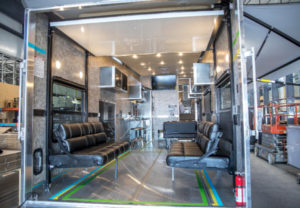
Our ATC Toy Hauler has an aluminum floor that runs the entire length of the trailer. This allows people to load up as much “toys” as possible. Most toy haulers, by contrast, extend the “garage floor” up to the kitchen, and from there on use a stylish composite floor.
Having a garage floor that runs the entire length of the trailer, even into the bedroom, means having to lay carpet. We use throw rugs that we can either sweep out or just take outside and shake.
That aluminum floor does get really cold, however. We don’t have the underside insulation, which is an available option, but we just didn’t add it. The carpets do help keep things more bearable.

If you were to roll motorcycles, quads, or other vehicles into the toy hauler, dirt and mud will drop all over the floor. You may even get oil drippings. You’ll also get fumes from the exhaust and engine. Toy haulers have vents on the walls to bring in wind to air out the trailer during tow).
Hence, a toy hauler floor is typically designed to be durable, not so much pretty and stylish. Even though some toy hauler manufacturers have found stylish materials that make durable floors, don’t expect to get that gorgeous, redwood plank flooring. Our ATC Toy Hauler, for example, is a shiny, metal aluminum floor with ridges for tire traction. But then again, if you want the ultimate in durability, that’s what you get.
That Larger Cargo Carrying Capacity
Toy haulers are meant to carry heavy cargo, hence they come with heavier axles that allow for larger gross vehicular weights. Where most travel trailers have a CCC ranging from 750 pounds to 1,500 pounds, toy haulers have a CCC ranging from 2,500 pounds to 7,000 pounds. That CCC goes higher when you get into those 40+ foot fifth wheel toy haulers.
Keep in mind that having a larger gross vehicular weight may push you over the top in some states as far as licensing goes. In California, for example, trailers over 10,000 pounds gross vehicular weight requires you to get a “Non-Commercial Class A” driver endorsement.
Our 28 foot ATC Toy Hauler has a gross vehicular weight of 11,444 pounds. Just keep that in mind if you’re based in California.
But having that larger cargo carrying capacity is useful if you’re planning to live full time in a trailer. That’s because you’ll want more of your things.
Now, I realize many of you are shaking your heads because you’re committed to a life of minimalism. But let me tell you this, Sash and I started out as committed minimalists too, but after living on the road since 2013, you realize the joy of paring down to the bare essentials only lasts for so long.
Eventually, you learn you want more out of life. Sash wants to do arts and crafts, sew her own clothes, explore new recipes to cook, and this means bringing in more supplies, more tools, and more cookware. And for me, I slowly accumulate more tools, because over the years, I realize I need them to maintain and repair the trailer. So, if you’re planning to put in several years of living in an RV, you definitely will want that larger CCC.
Of course, towing a trailer with that much more cargo weight means requiring a larger tow vehicle. My toy hauler’s actual weight (not gross vehicular weight), with everything in it, including a full water tank, and full fuel tank (for the Onan generator), runs between 9,000 to 10,000 pounds. My Chevy 2500 HD gas pickup truck can tow it just fine, but going up those mountain grades in Colorado can be slow, and I’m generally doing 40-45 MPH at 4,000 RPMs. If you’re thinking of living in a toy hauler, keep in mind the extra cargo weight you’ll end up accumulating.
That Industrial Look
While some toy hauler brands offer interior designs that look just as luxurious as Grand Designs and Airstreams, the interior of a stock ATC Toy Hauler looks more industrial, more like a “man cave”. That’s because it’s built from 100% aluminum. A lot of women don’t like that kind of look.
Sash managed to a pretty good job of decorating our interior. She came with a way to make it look “Bohemian” while still keeping the floorplan open and functional. If you want to get an ATC Toy Hauler, either you’ll have to learn to like the “man cave” look, or let your wife have more control over the decorating
Fold Up Furniture
Most toy haulers have some degree of “fold up furniture”. They have tables that fold up against the wall to make room for vehicles. They’ll offer fold up couches and fold up counters. They all offer a “Happi Jac” bed, which is a bed that lifts up flat against the ceiling and can be lowered down for use.
When we ordered our toy hauler, we didn’t get any furnishings aside from cabinetry, master bedroom, and standard kitchen amenities. Sash opted to bring in her own furnishings she picked out from thrift stores. However, we did have ATC Toy Haulers design a couple of fold up work stations for us.
So, we still have a certain degree of “fold up” stuff.
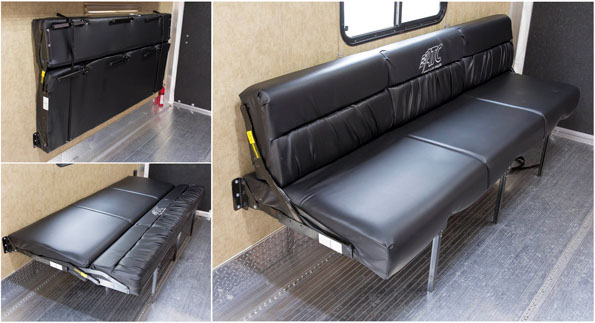
If you buy a toy hauler, you have to get used to the fold up lifestyle. They’re still comfortable to sit on or sleep on. Even with the larger fifth-wheel toy haulers that have a separate garage from the living quarters, the garage still has fold up furnishings.
Guys I’ve met don’t seem to care. We love fold up stuff. It’s the wives who want the stylish interiors.
Overall
Living in a toy hauler really isn’t much more different than living in a travel trailer. It’s still basically a travel trailer, and many RVers buy toy haulers to use as a travel travel, but want the extra durability.
Generally, where a travel trailer offers more stylish looks and that beautiful back wall window, a toy hauler offers more durability, more cargo carrying capacity, and a ramp door that can double as a deck.
But if you do decide to live in a toy hauler, without plans to load up vehicles, just know that you’ll accumulate more things, and will eventually need a bigger tow vehicle.

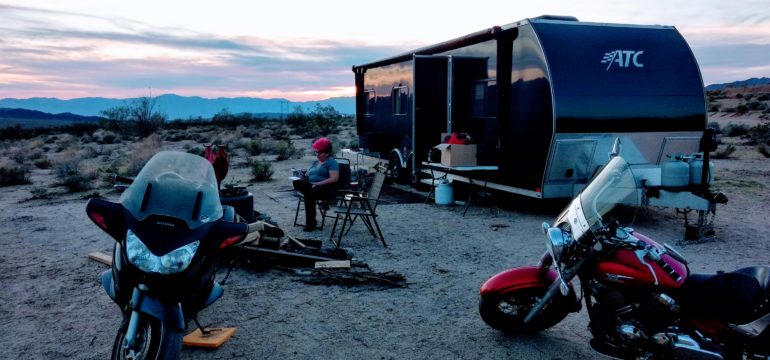

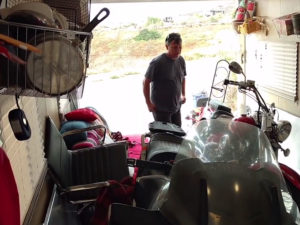


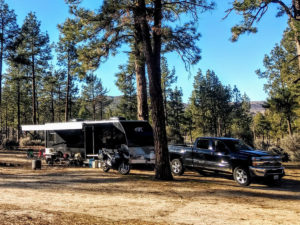



How big of a tow vehicle do you have for your toy hauler? How big of a toy hauler did you start out with? And how big of a truck did you end up upgrading to?